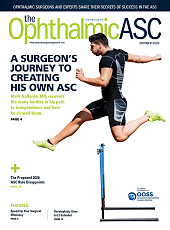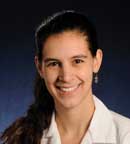Discussing treatment options available to patients affected with inherited retinal disease (IRD) is an important part of comprehensive care.1 Historically, treatment options for these conditions have been minimal, but the landscape is changing. This is in large part due to advances in gene therapy, which refers to the “introduction, removal, or change in the content of a person’s genetic code with the goal of treating or curing a disease.”2 Currently, there is one FDA-approved gene therapy for an IRD, voretigene neparvovec-rzyl (Luxturna; Spark Therapeutics),3 and other gene therapies are in clinical trials. These therapies represent a paradigm shift in the treatment of IRDs.
The emergence of new treatment options has created a growing need for patients to be well informed about gene therapy. Before hearing about gene therapy from ophthalmologists, other health care providers, or advocacy organizations, patients may first encounter the topic through newspapers, the internet, social media, or family and friends.4 Previous reports have shown that media sources often emphasize—and at times exaggerate—the positive aspects of new treatments, sometimes portraying them as cures.5 To successfully integrate gene therapy into the care of inherited retinal diseases (IRDs), patients must receive accurate, balanced information as well as appropriate support to help them make informed decisions.
Gene therapies are complex and can involve a substantial amount of information for patients and families to consider. By establishing realistic expectations about different aspects of these treatments, providers can help patients make informed decisions that align with their values and comfort with risk-benefit tradeoffs, ultimately supporting a positive patient experience.
Expectation #1: Eligibility for Gene Therapy Is not guaranteed
Eligibility for gene therapy varies according to treatment-specific and trial-specific criteria. Because these therapies often target the underlying genetic cause of disease, genetic test results are central to determining candidacy. For autosomal recessive conditions, eligibility requires the identification of biallelic pathogenic or likely pathogenic variants, meaning each copy of the gene carries a disease-causing variant. For example, Luxturna is indicated only for patients with “confirmed biallelic RPE65 mutation–associated retinal dystrophy.”3 Thus, a patient with only 1 RPE65 variant, with at least 1 variant classified as being of uncertain significance (VUS), or without evidence that 2 identified variants are located on different copies of the gene would not be eligible for this therapy.
If a patient has received inconclusive genetic test results, additional genetic analysis for family members or for the patient (particularly if the initial test was ordered many years ago) may be helpful in determining the specific cause of disease. Genetic testing of family members is often required to confirm the biallelic status of variants and may also be helpful in determining the meaning of a VUS. Rarely, ordering large panels and/or multiple tests can identify a second confirmed or possible genetic cause of disease, which may make a patient ineligible for gene therapy treatments or clinical trials. The presence of an additional genetic diagnosis introduces a confounding variable that may unpredictably influence the appropriateness, or expected outcome, of treatment. Involving a genetic counselor in the care of patients with a genetic eye disease can help to facilitate and interpret genetic testing, identify potential next steps for clarifying eligibility (ie, segregation analysis), educate patients and physicians about the results, and identify patients who may be eligible for gene therapy.
Although genetic criteria are usually the primary determinant of eligibility for gene therapy, this is not always the case. Some patients who do not have a genetic diagnosis may still be eligible for gene-agnostic therapy approaches. The presence of these types of therapies in the pipeline can help to preserve hope for treatment among patients who receive nondiagnostic genetic test results.
It is important to keep in mind that patients who meet genetic criteria for treatment may still be ineligible based on other ocular or extraocular features. For example, Luxturna requires that a patient have viable retinal cells.3 Other clinical trials may have a variety of inclusion criteria (eg, best corrected visual acuity within a certain range) and exclusion criteria (eg, high myopia, glaucoma, immune condition, infectious disease) unique to that treatment. Because some gene therapy treatments require the existence of remaining viable photoreceptor cells, patients with advanced disease may not be eligible for these therapies. However, it is possible that different treatment approaches, such as stem cell therapy or optogenetics, will be available for patients with later stages of disease.6
Patients who are eager to receive a treatment may request that exceptions be made for them. These situations require careful discussion to explain that inclusion and exclusion criteria are designed to ensure both patient safety and the validity of trial outcomes.
Expectation #2: Treatment Outcomes May Vary
No discussion of treatment, whether FDA-approved or part of a clinical trial, is complete without addressing expected outcomes. The current landscape of gene therapies for IRDs primarily aims to slow progression of disease, with some pipeline therapies aiming to restore some level of usable vision.7,8 However, a 2024 international survey of patients and caregivers found that 53% believed gene therapy could restore vision to normal.4 This suggests that patients and caregivers may hold overly optimistic expectations, which could affect satisfaction and clinical trial retention.
Providers should elicit patients’ and caregivers’ anticipated or desired outcomes before enrollment or treatment. This allows the provider to offer additional educational support and the patient to better evaluate their interest in the trial/treatment. For example, some patients may be interested in pursuing a treatment that is anticipated to increase mobility and ability to see in a dimly lit room, while others may only be interested in pursuing a treatment if it is anticipated to restore their ability to drive or read fine print. Retina specialists should take time to explore these personal perspectives with each patient to support personalized, informed decision-making.
There is always a chance that a patient’s response to therapy will be different from that of other documented cases. Although patients may see this fact as an invitation to hope for better results than have been previously reported, it is important to remind them that their results might also be less successful than other cases. Clinical trial participation carries the additional risk of unexpected adverse events associated with the treatment. Even after regulatory approval, unanticipated outcomes may occur, such as the retinal atrophy observed in patients treated with Luxturna after it received FDA approval.9
Patients should also be aware that receiving a one-time therapy, such as gene therapy, may impact their eligibility for future treatment options that emerge, which could have lower risks or improved outcomes. Given the rapidly advancing nature of IRD treatments, this may be a real concern for patients and may influence decisions about pursuing current treatment options.
Expectation #3: There are Barriers to Treatment
It is important for patients to understand that, in addition to facing constraints based on eligibility criteria for gene therapy treatment, there may be other barriers, including geographic location, frequency of visits, and cost. Often, the number of centers approved to offer these therapies is limited, which can present a geographical barrier. As of August 2025, there are only 19 treatment centers across 15 states that are able to administer Luxturna,10 and individual gene therapy clinical trials are often available at even fewer locations across the country. Additionally, gene therapies often require multiple pretreatment and posttreatment evaluations. This schedule of visits can present barriers, including transportation, time off from work or school, and travel fees.
The financial aspect of treatment may also be a barrier. The cost for the drug, procedure, and associated visits for an FDA-approved gene therapy are likely prohibitive for a patient who does not have health insurance or whose health insurance does not cover gene therapy. For clinical trials, cost is less of a barrier, because trial sponsors typically cover treatment-related expenses, including travel. However, some expenses may need to be paid out-of-pocket and submitted for reimbursement, and there may be other financial considerations, such as lost wages for the patient and/or a companion or childcare for dependents.
Even once a patient is determined to be eligible, and all potential barriers are overcome, still there are many logistical and operational aspects to receiving gene therapy that can ultimately impact the time to treatment. For approved therapies, this can include factors such as obtaining insurance authorization and scheduling surgery. For clinical trials, this may include the schedule that is defined by the protocol and the recruitment status of the trial. As a result, the time to treatment is unique to every patient. Given the progressive nature of most of these conditions and the relative lack of treatment options, this may be frustrating for patients who are eager to receive treatment.
Conclusion
Fostering realistic expectations for gene therapy among patients with IRDs can help them make informed decisions if/when treatment becomes an option for them. Even with realistic expectations, patients may benefit from additional psychosocial support. Discussions about gene therapy for IRDs have been ongoing for many years, and patients who are found to be ineligible may experience a sense of lost hope for themselves and their families. Regardless of eligibility, providing support and resources is essential. This may include educational materials, low-vision resources, information on support groups, and mental health services. Offering such support can help patients living with these progressive diseases remain engaged in follow-up care and maintain hope amid the rapidly advancing and evolving landscape of IRD treatment. RP
Reference
1. Branham K, Yashar BM. Providing comprehensive genetic-based ophthalmic care. Clin Genet. 2013;84(2):183-189. doi:10.1111/cge.12192
2. American Association of Gene and Cell Therapy. Glossary. Accessed September 5, 2025. https://www.asgct.org/education/more-resources/glossary.
3. Spark Therapeutics. Highlights of presribing information for Luxturna. May 2022. Accessed September 5, 2025. https://www.gene.com/download/pdf/luxturna_prescribing.pdf.
4. Britten-Jones AC, McGuinness MB, Chen FK, Grigg JR, Mack HG, Ayton LN. A multinational survey of potential participant perspectives on ocular gene therapy. Gene Ther. 2024;31(5-6):314-323. doi:10.1038/s41434-024-00450-4
5. Benjaminy S, Kowal SP, MacDonald IM, Bubela T. Communicating the promise for ocular gene therapies: challenges and recommendations. Am J Ophthalmol. 2015;160(3):408-415.e2. doi:10.1016/j.ajo.2015.05.026
6. Jacobson SG, Cideciyan AV. Treatment possibilities for retinitis pigmentosa. N Engl J Med. 2010;363(17):1669-1671. doi:10.1056/NEJMcibr1007685
7. Duncan JL, Pierce EA, Laster AM, et al. Inherited retinal degenerations: current landscape and knowledge gaps. Transl Vis Sci Technol. 2018;7(4):6. doi:10.1167/tvst.7.4.6
8. Sahel JA, Boulanger-Scemama E, Pagot C, et al. Partial recovery of visual function in a blind patient after optogenetic therapy. Nat Med. 2021;27(7):1223-1229. doi:10.1038/s41591-021-01351-4
9. Gange WS, Sisk RA, Besirli CG, et al. Perifoveal chorioretinal atrophy after subretinal voretigene neparvovec-rzyl for RPE65-mediated leber congenital amaurosis. Ophthalmol Retina. 2022;6(1):58-64. doi:10.1016/j.oret.2021.03.016
10. Spark Therapeutics. Ocular gene therapy treatment centers. Accessed September 5, 2025. https://luxturnahcp.com/about-luxturna/treatment-centers











